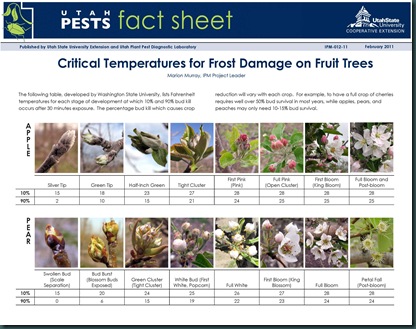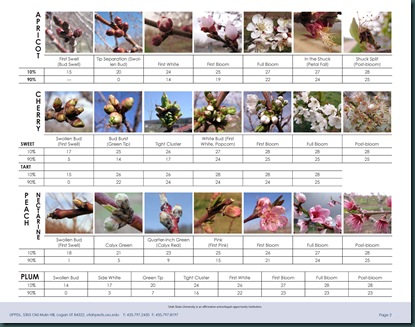This spring has marked another unprecedented weather pattern that raised our temperatures in late March and lowered early April temperatures to below normal. It seems that each spring since 2012, we have been on the verge of critical temperatures for frost damage with our fruit trees.
As the trees develop in the spring and buds start to
swell, they lose the ability to withstand the cold winter temperatures
that they could withstand in dormancy during the cold winter months. The
young, actively growing tissue can then be damaged or even killed.
Swollen fruit buds can better withstand temperatures in the teens
without any damage. As the buds open, temperatures in the low 20s can
cause harm, but sometimes leave other buds undamaged. As growth moves
from green tip to 1/4” green to 1/2” green to tight cluster to pink in
apple trees, temperatures in the upper 20s can cause considerable harm
to an early blooming tree. Near bloom, the range between slight and
severe damage can be very small. So the stage of bud development
determines how susceptible any given fruit crop is when freezes occur.
For more information on what those critical temperatures are that can
cause freeze damage to trees during development, I have added two
charts on the Critical Temperatures For Frost Damage on Fruit Trees from Utah State University below that you can download by
clicking on either chart below.
Given
the weather patterns we have experienced so far this spring, and the
fact that we have gotten snow as late as mid April, a spring frost could be possible within the next few weeks. We will need to constantly
assess the stage of development our trees are at and their
susceptibility to freeze injury. If we continue in this spell of colder
weather, apple trees will continue to develop more slowly, but once they begin showing tight cluster and pink, the critical temperature rises from the low 20’s to the high 20s, to levels just below freezing at bloom time.


No comments:
Post a Comment
Comments are welcome! All comments are moderated, so you will see your comment posted here as soon as we have reviewed it! Questions are best asked via email for a quicker response. Address your questions to service@royaloakfarmorchard.com.
Note: Only a member of this blog may post a comment.